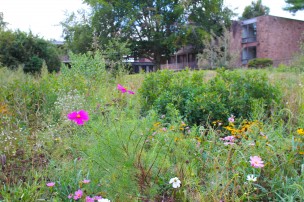Over the summer, WILD Wes focused on site maintenance, repairing the water catchment systems, and planting new greenery native to Connecticut, such as fruit trees, herbs, and ferns in the WestCo courtyard. In the Butterfields, the group completed new terraces and finished first-stage plant implementation.
Working for Intelligent Landscape Design at Wesleyan (WILD Wes) hired four student interns—Rina Kremer ’15, Eli McClintock-Shapiro ’17, Zach Mollendor ’15, and Ian Rice ’17—to remain at the University over the summer to reform the landscape of two areas of campus: the West College (WestCo) courtyard and the Butterfields stairs and terraces, otherwise known as the Summerfields site.
WILD Wes is a student organization that aims to shift the landscape of the University according to the principle of permaculture, which is a type of ecological design that attempts to develop a self-sustaining ecosystem of wildlife native to the region. Ideally, all elements of the landscape, including the humans who tend it, help support the rest of the life in the environment.
Mollendor explained the environmental goals of the organization.
“The goal of WILD Wes is to use land in a more sustainable and productive fashion,” Mollendor wrote in an email to The Argus. “By going back to the way of natural farming, we can use less water, be more productive (generate produce), and help restore ecosystems.”
Kremer noted some of the potential benefits of permaculture to all parties in the ecosystem.
“A plot of land left to function as it ‘naturally’ would or re-landscaped to function like it ‘naturally’ would is a win-win(-win) situation,” Kremer wrote in an email to The Argus. “For instance, we get a healthier, productive space (cleaner air, food, soil,); bugs and animals get a livable habitat; and, the land, air, and water or the world is kept cleaner by avoiding the use of man-made chemicals, inputs, and fossil-fueled machinery on site.”
Over the summer, WILD Wes focused on site maintenance, repairing the water catchment systems and planting new greenery native to Connecticut such as fruit trees, herbs, and ferns in the WestCo courtyard. In the Butterfields, this group completed new terraces and finished first-stage plant implementation.
Many of the newly planted trees in the WestCo courtyard will begin to bear fruit in the coming years. The area hosts pear, apple, plum, cherry, peach, persimmon, and paw paw trees. McClintock-Shapiro stated that the fruit is free to anyone.
“There is a Bosc Pear tree in the center of the orchard area,” McClintock-Shapiro wrote in an email to The Argus. “It currently is covered in pears, which are free for people to pick! However, Bosc pears are rather difficult to get to ripen correctly. They should be picked in mid to late September, refrigerated for three weeks, and then put in a paper bag for a few days before eating.”
WILD Wes began their work on the WestCo site with a student forum in spring 2011, where members designed an implementation plan. The Summerfields site was acquired later in fall 2012, and the planting began there in spring 2013. Both sites currently have ongoing work.
“These sites always have been and always will be continuous educational, experimental, and growing…permaculture projects, but my hopes for the reasonably-near future is that we can start to get some serious harvests out of the site (more productivity) as well as some more year-round color/‘life,’” Kremer wrote.
In the coming months, the organization hopes to create stepping stones to access the new fruit trees, place signs to identify plants, and to continue adding to the plant life.
“I think one major challenge we face with the site is that it is…most beautiful and productive during the months when students aren’t here,” Rice wrote in an email to The Argus. “We are hoping to plant more winter plants to add color to the school during the dreary winter months.”
Kremer stated that although work on both sites will continue, the organization is also hoping to expand into the Middletown community.
“Though I would like to see it expand on campus, I think it’d be a good idea to start creating stronger ties to the greater communities,” Kremer wrote. “Partnerships with nearby schools would also be neat, or forging ties with other universities that have their own permaculture projects. Something that would make what we do more accessible and/or applicable to a community larger than Wesleyan would be a good next step.”
Mollendor added that WILD Wes also hopes to continue educating University students this year.
“WILD Wes provides the campus environment with an eco-friendly alternative to non-eco-friendly grass lawns,” Mollendor wrote. “As for the campus community, it provides people with an outlet to get involved with something that’s not only eco-friendly but also really fun and rewarding. From personal experience, going into this summer as a WILD Wes intern, I didn’t even know what a ‘weed’ was. I have learned a great deal since then.”
As work continues on both the WestCo and Summerfields sites, Kremer stressed the profound impact of recreating a natural ecosystem.
“WILD Wes/the permaculture model demonstrates the alternative landscaping systems we not only could but should have in our current structure of ‘developed’ life for a longer and healthier future,” Kremer wrote. “A plot of urban land doesn’t have to be a watered lawn or a manicured production of blue roses and topiary…. It’s pretty incredible once you take a hot second to think about all of the positive chains of events that a simple idea like permaculture—letting ‘nature’ be ‘nature’—can have.”

Comments are closed